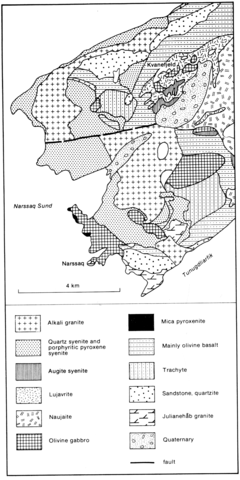stripes
This is one of the least known Gardar intrusions, no full account having yet been published. It lies on the northwest margin of Ilimaussaq and appears to have been torn into two parts by one of the major east-west-trending sinistral faults (Emeleus and Upton, 1976, p. 171). The oldest major unit is the layered Narssaq gabbro which Emeleus and Upton (1976, p. 171) consider to represent a high-level culmination of the gabbroic giant dykes occurring to the west on Tugtutoq (No. 28). The gabbro was succeeded by the Dyrnaes syenite in which Olsen (1977) distinguishes five units of leucocratic porphyritic syenite and augite and quartz syenite. One syenite unit contains numerous, indistinct, dark 4 cm thick layers and two small bodies of what appear to be younger biotite gabbros. Later mapping (Olsen, 1978) in the northern part of the complex indicated more complex relationships. The last major intrusive episode was of homogeneous alkali granite which is cut by dolerite dykes, but not by the trachytes which cut the syenites. Data on fluid inclusions in the granite are given by Konnerup-Madsen et al. (1985).
EMELEUS, C.H. and UPTON, B.G.J. 1976. The Gardar period in southern Greenland. In A. Escher and W.S. Watt (Eds). Geology of Greenland. Gronlands Geologiske Undersogelse: 153-81.
Konnerup-Madsen et al., 1985; Olsen, 1977 and 1978.


